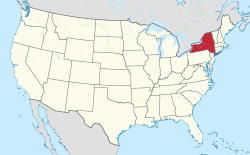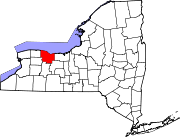Honeoye Falls, New York
Honeoye Falls | |
|---|---|
 A small waterfall on Honeoye Creek, which gave the town its name | |
 Location in Monroe County and the state of New York. | |
 Location of New York in the United States | |
| Coordinates: 42°57′23″N 77°35′14″W / 42.95639°N 77.58722°W | |
| Country | United States |
| State | New York |
| County | Monroe |
| Township | Mendon |
| Incorporated | 1791 |
| Government | |
| • Mayor | Richard B. Milne (2007) |
| Area | |
| • Total | 2.60 sq mi (6.72 km2) |
| • Land | 2.54 sq mi (6.59 km2) |
| • Water | 0.05 sq mi (0.13 km2) |
| Elevation | 668 ft (204 m) |
| Population (2020) | |
| • Total | 2,706 |
| • Density | 1,064.10/sq mi (410.83/km2) |
| Time zone | UTC-5 (EST) |
| • Summer (DST) | UTC-4 (EDT) |
| ZIP code | 14472 |
| Area code | 585 |
| FIPS code | 36-35364 |
| Website | http://www.villageofhoneoyefalls.org/ |
Honeoye Falls (/ˈhʌniɔɪ/ HUN-ee-oy)[2] is a village within the town of Mendon in Monroe County, New York, United States. The population was 2,706 at the 2020 census. The village includes a small waterfall on Honeoye Creek, which flows through the village and gives it its name. The name Honeoye comes from the Seneca word ha-ne-a-yah, which means lying finger, or where the finger lies. The name comes from the local story of a Native American whose finger was bitten by a rattlesnake and who therefore cut off his finger with a tomahawk.[3][4]
History[edit]
The village was founded in 1791 by Zebulon Norton when he purchased 1,820 acres (7.4 km2) of land for the price of 12½ cents per acre. He built a grist mill and later a sawmill, at a waterfall on Honeoye Creek. The area was originally known as Norton Mills. In 1827, Hiram Finch built a second mill, which would come to be called the Lower Mill to differentiate it from the earlier mill. On May 17, 1973, the Lower Mill was listed on the National Register of Historic Places. The Honeoye Falls Village Historic District, St. John's Episcopal Church, Totiakton Site, and United States Post Office are also listed on the National Register of Historic Places.[5]
| Name | Title | Term | Name | Title | Term |
|---|---|---|---|---|---|
| Harry Allen | President | 1838 1865 |
James Heath | President | 1918–1923 |
| Henry Lockwood | President | 1839 | James S. Brown | President | 1924–1925 |
| Edward Downs | President | 1840 | F.F. Jobes | President | 1926 |
| Stephen Barrett | President | 1841–1842 | William Despard | Mayor | 1927 |
| Richard Ostrander | President | 1845–1864 | Basil Moore | Mayor | 1953–1963 |
| C.R. Hyde | President | 1867 | Bernard Drowne | Mayor | 1963–1968 |
| William Burberry | President | 1868 | Squire Kingston | Mayor | 1969–1971 |
| J.F. Kellogg | President | 1870–1872 1874–1884 |
William E. Clark | Mayor | 1972–1973 |
| W.G. Starr | President | 1873 | William Mantegna | Mayor | 1973–1981 |
| Milo Case | President | 1884 | Mary Louise Meisenzahl | Mayor | 1981–1990 |
| W.R. Yorks | President | 1887 1896 |
Anne R. Morton | Mayor | 1991 – October 2000 |
| Seymour Pierce | President | 1888 1892 1905 |
Stephen R. Gustin | Mayor | October 2000 – 2005 |
| H.A. Tripp | President | 1889 | Richard B. Milne | Mayor | 2005 – present |
| J.W. Flick | President | 1890 | |||
| John Martin | President | 1894 1904 |
|||
| William Lay | President | 1897 1901 1904 |
|||
| Martin Pierce | President | 1899–1900 | |||
| A.H. Holden | President | 1906 | |||
| Levi Hill | President | 1907–1914 | |||
| C.S. Lange | President | 1915–1917 |
Honeoye Falls experienced an epidemic of scarlet fever in April 1893.[6]
Geography[edit]
The village is located on the falls of Honeoye Creek. It is the primary outlet of Honeoye Lake.
Honeoye Falls is located at 42°57′23″N 77°35′14″W / 42.95639°N 77.58722°W (42.956331, −77.587353).[7] The village is in the most southeastern corner of Monroe County, approximately 13 miles outside of the City of Rochester.
According to the United States Census Bureau, the village has a total area of 2.6 square miles (6.7 km2).
Demographics[edit]
| Census | Pop. | Note | %± |
|---|---|---|---|
| 1870 | 921 | — | |
| 1880 | 1,098 | 19.2% | |
| 1890 | 1,128 | 2.7% | |
| 1900 | 1,175 | 4.2% | |
| 1910 | 1,169 | −0.5% | |
| 1920 | 1,107 | −5.3% | |
| 1930 | 1,187 | 7.2% | |
| 1940 | 1,274 | 7.3% | |
| 1950 | 1,460 | 14.6% | |
| 1960 | 2,143 | 46.8% | |
| 1970 | 2,248 | 4.9% | |
| 1980 | 2,410 | 7.2% | |
| 1990 | 2,340 | −2.9% | |
| 2000 | 2,595 | 10.9% | |
| 2010 | 2,674 | 3.0% | |
| 2020 | 2,706 | 1.2% | |
| U.S. Decennial Census[8] | |||
As of the census[9] of 2020, there were 2,706 people, 1,195 households, and 689 families residing in the village.[10]
As of the census[11] of 2000, there were 2,595 people, 1,114 households, and 672 families residing in the village. The population density was 1,000.3 inhabitants per square mile (386.2/km2). There were 1,156 housing units, with an average density of 445.6 per square mile (172.0/km2). The racial makeup of the village was 97.15% White, 1.00% African American, 0.15% Native American, 0.77% Asian, 0.00% Pacific Islander, 0.23% from other races, and 0.69% from two or more races. 1.04% of the population were Hispanic or Latino of any race.
Out of 1,114 households, 30.2% had children under the age of 18 living with them, 46.7% were married couples living together, 11.1% had a female householder with no husband present, and 39.6% were non-families. 34.8% of all households were made up of individuals, and 18.0% had someone living alone who was 65 years of age or older. The average household size was 2.26 and the average family size was 2.95.
In the village, the population was spread out, with 24.2% under the age of 18, 5.6% from 18 to 24, 26.4% from 25 to 44, 25.2% from 45 to 64, and 18.5% who were 65 years of age or older. The median age was 41 years. For every 100 females, there were 80.3 males. For every 100 females aged 18 and over, there were 74.2 males.
The median income for a household in the village was $47,413 and the median income for a family was $66,818. Males had a median income of $46,136 versus $35,299 for females. The per capita income for the village was $27,987. 2.5% of the population and 0.6% of families were below the poverty line. 2.3% of those under the age of 18 and 4.6% of those 65 and older were living below the poverty line.
Quick summary:
- Males (44.5%), Females (55.5%)
- White (96.5%), Hispanic (1%), Black (1%), Two or more races (.7%)
- Median resident age – 41.2 years old
- Median household income in 2000 – $47,413
- Median house value in 2000 – $123,500
Government[edit]
This section needs expansion. You can help by adding to it. (December 2011) |

The village is governed by a board consisting of a mayor and four trustees, all elected by registered village voters.
The Board of Trustees are: Mayor Richard B. Milne, Trustee Jacquelin Main, Trustee Shari Stottler, Trustee Daniel Harris, and Deputy Mayor Stanley E. Worboys Jr.[12]
Justice Sheldon Boyce presides over the Village Court.[13]
Education[edit]
Public schools in Honeoye Falls are part of the Honeoye Falls-Lima Central School District. Schools within the village include Honeoye Falls-Lima Senior High School, Honeoye Falls-Lima Middle School, and Manor Intermediate School. The Lima Primary School is in the district but located in the Town of Lima. The School mascot is the Cougar.
93.2% of the population 25 years and older hold a high school diploma or higher, 43.5% a bachelor's degree or higher, and 16.4% a graduate/professional degree.[citation needed]
Notable people[edit]
- David Francis Barry, 19th century photographer of the American West
- Truddi Chase, author of "When Rabbit Howls"
- Charles A. Goheen, Medal of Honor recipient for the American Civil War
- Delia C. Kenyon 1858-1945, Businesswoman, suffragist and clubwoman[14][15]
- Marty Reasoner, hockey player
- Joan Smith, Olympic biathlete
Events[edit]
- Festival on the Green – Popular music and art event for local talent.
References[edit]
- ^ "ArcGIS REST Services Directory". United States Census Bureau. Retrieved September 20, 2022.
- ^ Honeoye Lake Area Chamber of Commerce honeoyelakechamber.org, accessed March 16, 2012.
- ^ Beauchamp, William Martin (1907). Aboriginal Place Names of New York (New York State Museum Bulletin, Volume 108). New York State Education Department. pp. 157–158. ISBN 9781404751552. Retrieved June 8, 2015.
- ^ "Early History of the Town of Richmond". Archived from the original on March 13, 2012. Retrieved June 8, 2015.
- ^ "National Register Information System". National Register of Historic Places. National Park Service. July 9, 2010.
- ^ State and Vicinity. April 23, 1891. The Holley (NY) Standard. 1.
- ^ "US Gazetteer files: 2010, 2000, and 1990". United States Census Bureau. February 12, 2011. Retrieved April 23, 2011.
- ^ "Census of Population and Housing". Census.gov. Retrieved June 4, 2015.
- ^ "Explore Census Data". data.census.gov. Retrieved March 18, 2023.
- ^ "Explore Census Data". data.census.gov. Retrieved March 18, 2023.
- ^ "U.S. Census website". United States Census Bureau. Retrieved January 31, 2008.
- ^ "Village Officials".
- ^ "Village Court".
- ^ "Delia Kenyon". rrlc.org. Retrieved March 15, 2024.
- ^ "Delia C. Kenyon". WATVNYS. Retrieved March 15, 2024.

